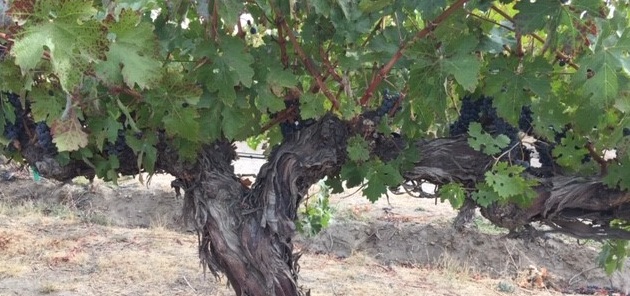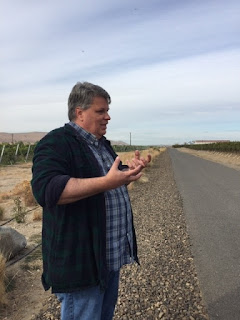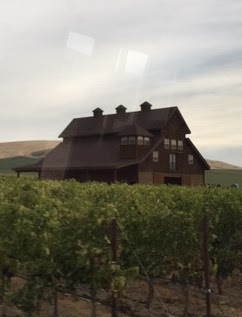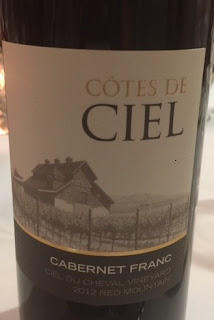 |
| Old vine Cabernet Sauvignon in Red Mountain’s Ciel du Cheval date to the 1970s |
 |
| Richard Holmes |
Richard Holmes of Eastern Washington’s Ciel du Cheval vineyards says the land is all garbage.
He sure knows how to get the attention of a group of wine geeks!
Yes, I am a wine geek, and I love all things about fermented grape juice, from dirt to bottle. The soil, the rocks, the vines, the different clones, the trellising systems, the picking, the crushing, the aging, the wine makers — these things fascinate me so much that, well, I write a wine blog.
Holmes, a second-generation Red Mountain man, is the son of Jim Holmes, who partnered in the mid 1970s with John Williams of Kiona Vineyards in Eastern Washington State to establish some of the first vines in the then untested viticultural area now known as Red Mountain AVA (see more about Kiona in my last posting). Holmes the Younger knows all the dirt about the dirt, and he basically says that everything between western Montana and the Pacific Ocean is garbage.
But it’s great garbage for grape growing, it turns out.
“The soil within the Red Mountain AVA distinguishes it,” says Holmes, who was tour guide for the Wine Blogger’s Conference 2018 excursion to Red Mountain AVA.
Missoula Floods
 |
| Red Mountain soils are good for grape growing |
At the end of the last ice age, roughly 15,000 years ago, cataclysmic flooding from Missoula, Montana, sent water and ice roaring down what is now the Columbia Basin in Washington and the Willamette Valley in Oregon. These Missoula Floods created a buildup of bedrock and soil, with volcanic eruptions from the Cascade Mountains adding layers of ash (the 1980 eruption of Mt. St. Helens added even more). The Red Mountain ridge stopped the water, forcing it to flowed around it, churning up that earth and creating the crazy mix of soils that exist there today. There’s lots of decomposed rock and calcium carbonate, which is bad for growing anything but grapes.
Back in 1975, Holmes the Elder and a few others had a hunch that this tough, barren, sage-filled desert land had the potential to grow quality wine grapes. The soil had the right pH for grapes, it had great drainage created from the ancient flooding which would allow vines to develop deep roots, and the rainfall was low — just 5-9 inches annually — which would allow for controlled irrigation.
An additional benefit of Washington soils is that it’s low in clay, which, Homes believes, is why there has been so little phylloxera in the state. Most of Washington’s vines are on their own rootstock. But the pest called nematodes can be a problem.
Ciel Du Cheval Vineyards
 |
| Ciel du Cheval’s barn sits amidst the vines |
The vineyard is managed by Dick Boushey, who hails from apple farming, which is prevalent in this neck of the woods. Dick was our tour guide as we traveled through the 260-acre vineyard on a Red Mountain Trails horse-drawn wagon.
This is the best tour of a vineyard I’ve ever experienced, as it allowed us wine geeks to get up close to thousands of vines growing all different grapes for many different wineries, using various trellising and pruning systems. Boushey took great pleasure in pointing out the differences among rows, as some producers prune, trim and cut back their vines in a pristine fashion, while others prefer the ‘au natural’ method.
It was harvest season during our tour, which makes the incredible hospitality we received even more amazing, but it also sparked conversation about managing a vineyard with the current labor shortage among vineyard workers. Boushey was quite vocal on the subject, and proudly boasted that his workforce is all women, whom he pays $30 to $50 per hour (gulp!). Grapes are much lighter than apples to haul, so women gravitated toward the vineyards, he says. And, as most of his customers want their grapes handpicked, he believes that the women workforce handles the grapes better as they are more detail oriented. Needless to say, I liked this guy! About one third of the vineyard’s workforce has been with them for three years. (For an interesting read on this, see Karen McNeil’s recent article.)
In addition to the many vintners he grows for, he also provides grapes for Welch’s grape juice, and they pay much more for the grapes (approximately 35%).
The Ciel du Cheval vineyards are not organic, which Boushey says costs approximately 35% more in terms of production. He views organic as a philosophy, not a viticultural approach. However, Hedges Family Estates, which sits right next to Ciel du Cheval, has a strong biodynamic, organic leaning, and is currently transitioning all its vines. Makes you wonder how long they can coexist peacefully.
Experimentation Continues
Red Mountain, and specifically Ciel du Cheval, are not resting on their laurels. Both Holmes and Boushey made it very clear that they will continue to rip out older blocks and replace them with new, different vines and clones. As an example, for Cab Franc, they have planted three different clones, which on their own don’t shine, but blended together provide what they are looking for in a Red Mountain Cab Franc. They also have four different Syrah clones, one from Beaucastel in the Rhone.
“After 43 years here, we are just beginning to learn,” says Holmes.
Cotes de Cheval
 |
| Cotes du Cheval Cab Franc is a winner! |
The estate wines of Ciel de Cheval, called Cotes de Ciel, are available to taste at their downtown Walla Walla tasting room.
Holmes wines are big, bold reds mostly, with one exception (at least when I tasted there), Roussanne. “On tap” were Holmes’ Merlot, Petit Verdot, Red Blend, Cabernet Sauvignon, and Counoise, to name a few. I especially liked the Cabernet Franc and brought some home with me.
The tasting room is shared with Gino Cuneo Cellars, which is solely dedicated to classic Italian varieties, like Nebbiolo and Barbera. Cuneo also makes Ripasso and Rosato.
Red Mountain flavors and quality shone through in both wineries’ wines.
The best way to see Red Mountain AVA is through Red Mountain Trails tour. To learn more about them visit www.redmountaintrails.com.
Related reading: Karen McNeil’s “How Latina Women are Saving California Wine.”
Until next time, Cheers!

